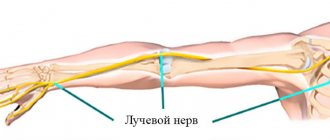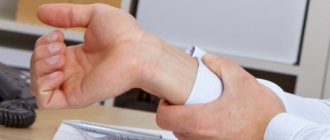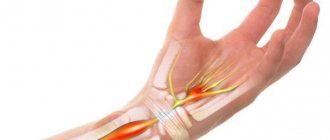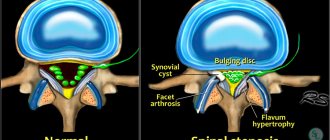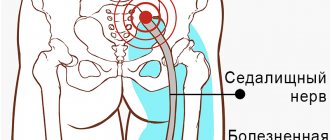Numbness in the fingers occurs for a variety of reasons. In young people, in most cases, quickly passing numbness is a consequence of physiological causes that can be established independently; this pathology does not require specific treatment. However, loss of sensitivity in the fingers can also be an initial symptom of serious diseases, which are best treated at an early stage. Therefore, if numbness occurs frequently and for a long time, you should not postpone a visit to the doctor.
Kinds
Before contacting a specialist for qualified help, it is important to determine the type of tingling (the medical definition is paresthesia). Thus, each type of illness speaks of various types of disorders in the body.
- The little finger of the right hand goes numb - the nerves are pinched and cervical osteochondrosis develops.
- Middle finger – damage to the cervical vertebrae of the collar zone occurs.
- Ring finger – if the finger is not pulled over the wedding ring, then muscle strain should be suspected.
- Numbness in the thumbs of the right and left hands - the cause may lie in a basic lack of vitamins, muscle strain or inflammation of the brachial nerve. But you should also be wary of more dangerous diagnoses, namely: pre-stroke condition, disturbances in the functioning of the nervous and cardiac systems.
- The index finger goes numb when the metabolic system does not work properly, or when the nervous system malfunctions due to stress and breakdowns.
- The little finger and ring fingers of the left hand – the functions of the cardiovascular system are impaired.
Causes
Carpal tunnel syndrome
Carpal tunnel syndrome is compression of the median nerve in the hand area, where the median nerve runs in an anatomically narrow place along with the tendons and is covered by the retinaculum ligament.
How does it manifest?
The hands begin to go numb at night, the person is forced to wake up from this numbness and shake his hands. Gradually, this condition becomes more frequent, then the fingers begin to go numb during the day during any movements with the hands. In advanced stages, weakness in the hand appears and the person cannot hold various objects. Most often, carpal tunnel syndrome develops in people who constantly work with their hands: office workers, massage therapists, workers.
Cubital tunnel syndrome
Cubital tunnel syndrome is compression of the ulnar nerve in the area of the elbow, where we feel pain and shooting along the nerve when we hit the elbow (inside), which everyone has experienced at some point.
How does it manifest?
The first symptom is the little finger going numb. Then weakness appears in the fingers (ring, little finger), and it becomes difficult to hold objects. Hand atrophy may occur. Numbness most often occurs during the day, while working with your hands or when lifting your hands. Men get sick more often than women.
Anterior scalene syndrome
Anterior scalene syndrome is compression of the brachial plexus in the interscalene space in the neck (between the anterior and middle scalene muscles).
How does it manifest?
The symptoms are the same: numbness in the little finger and ring finger, then weakness in the hand. Occupational complication: for example, occurs in musicians who play the violin for a long time for several hours. Or at hairdressers during a long haircut in a static neck position.
Radiculopathy
Radiculopathy is compression of the spinal roots. The cause, as a rule, lies in a herniated disc. There are 3 roots going to the fingers: C6, C7, C8. Radiculopathy of the C6 root is more common.
How does it manifest?
The first symptoms are numbness in the thumb and index finger. Radiculopathy is usually accompanied by pain in the neck and radiating to the arm. Numbness in the fingers intensifies with any movements in the neck.
Causes
Paresthesia is not always associated with a painful condition of the body (neuralgia). Non-medical causes of numbness in the fingers include:
- general hypothermia of the body or upper extremities;
- consequence of hand injury;
- sleeping in an unnatural position;
- poisoning of the body with alcohol, drugs, chemicals;
- wearing tight-fitting jewelry (rings, bracelets);
- keeping your fingers in one position for a long time (knitting, typing on the keyboard).
REFERENCE! During pregnancy, a woman may experience numbness in her limbs due to the increased load on the body and hormonal changes.
If tingling is felt with constant frequency and is present in the same limb or finger, you should immediately contact a specialist for timely diagnosis and prescription of effective treatment.
Medical causes of the disease include:
- osteochondrosis;
- intervertebral hernia;
- tunnel syndrome;
- inflammatory processes in the joints;
- failure of the cardiovascular system;
- cerebral hemorrhage;
- brain activity disorders;
- improper blood circulation against the background of developing diabetes mellitus;
- thrombosis;
- disruption of the endocrine system;
- nail fungus;
- avitaminosis.
It should be borne in mind that the proper functioning of the body directly depends on the lifestyle that a person leads. Bad habits have a tremendous impact on the body's ability to function properly.
Why does the little finger on my left hand go numb?
Paresthesia on the left requires special attention. They can be a sign of cardiovascular pathologies: angina pectoris, myocardial infarction and stroke. These conditions are accompanied by concomitant symptoms, but there are also isolated cases when only the little finger on the left hand goes numb , and then the clinical picture unfolds.
Etiological factors also include osteochondrosis, local ischemia and other pathologies listed for the corresponding finger on the opposite side.
Which doctor treats
For regularly recurring attacks of paresthesia, seeking professional medical help is a must. First of all, you need to make an appointment with a neurologist.
When choosing a clinic, you should take into account the presence of its own diagnostic facilities, the experience and qualifications of the working specialists (in particular, neurologists).
ATTENTION! The Kuntsevo Treatment and Rehabilitation Center has an extensive diagnostic base in all possible areas (MRI, ultrasound, electroneuromyography, etc.) to quickly and accurately determine a patient’s diagnosis.
Basic tests and procedures to make a correct diagnosis:
- blood and urine tests;
- blood sugar level analysis;
- Ultrasound, ECG of the heart muscle;
- MRI of the hand;
- Dopplerography of blood vessels, etc.
If necessary, additional studies will be ordered to more accurately diagnose the patient.
Depending on the nature of the origin of the symptom, based on the tests performed, the specialist will prescribe the most effective treatment in each specific case. The clinic employs the best neurologists, orthopedic traumatologists, rheumatologists, endocrinologists, cardiologists, chiropractors, rehabilitation specialists and other specialized specialists with many years of experience.
Numbness of the fingers is a sign that indicates neurological disorders in a person’s limbs.
IMPORTANT! A slight decrease in sensitivity can become a real problem after some time if timely treatment is not started by a qualified specialist.
Self-medication, as in all other cases, threatens not only to complicate the situation, but also to develop other neurological disorders. Therefore, make an appointment with an experienced neurologist at our center, who will conduct a full range of diagnostics, determine the causes of your condition and prescribe effective treatment.
Sign up
Causes of numbness in fingers at night
At night, fingers most often go numb not due to illness, but from being in an uncomfortable position for a long time. Popularly this is called a “stuck” hand. The blood vessels are compressed under the weight of your body, and therefore the hand becomes numb. When the blood flow becomes normal again (you changed your position, rubbed your arm), the numbness goes away. When blood begins to rush to the area of the arm, an itching and/or slight tingling sensation is felt that lasts from a few seconds to several minutes.
The next reason why fingers go numb at night is clothing that pinches blood vessels. Therefore, you should not wear uncomfortable and tight pajamas, underwear, etc. at night. During sleep, when throwing your arms above the level of your heart, swelling and numbness are also possible. This happens if your hands are behind your head, under your head, etc.
If your bed or pillows are uncomfortable, numbness is also likely. It is better to give preference to orthopedic bedding.
Treatment methods
Treatment for numbness in the fingers is carried out in several ways.
- Drug therapy. The doctor selects a course of effective, maximally safe medications, creams or ointments to relieve inflammation, relieve swelling and eliminate severe pain.
- Local treatment. In this case, therapeutic massage or manual therapy is used.
- Physiotherapy. Treatment is carried out with laser, magnet or ultrasound. As a result of this approach, blood circulation in the body is normalized and damaged tissues are regenerated.
- Exercise therapy and gymnastics. Relieves pain, restores normal sensitivity in the limbs, and alleviates the general condition.
IMPORTANT! The priority area of work of the CLRC is conservative therapy. The prescription of powerful, at the same time safe, pain-relieving drugs is combined with manual therapy, physical therapy, physiotherapy and massages. Only an integrated approach will help achieve the desired result quickly and for a long time.
Professional causes of numbness in fingers
If a person’s daily work consists of frequently repeated, monotonous actions in which the hands are raised above the heart, then it is more difficult for the organ to pump blood. The pressure in the extremities decreases, so the fingers do not receive enough blood. A symptom such as numbness of the fingers appears.
If the job involves carrying heavy loads for a long time, the person will most likely also suffer from loss of tactility in the fingers of the upper extremities. If hyperventilation often occurs during work (for example, during exciting professional duties), this may ultimately also become the cause of the symptom in question.
Rehabilitation and lifestyle restoration
Rehabilitation programs at the CLRC are developed in different directions in order to select the most effective one in each individual case.
- Physiotherapy.
- Manual therapy.
- Reflexology.
- Physiotherapy.
- Massage.
- HILT therapy.
- Shock wave therapy (SWT).
- Electrotherapy (SMT therapy).
- Electrophoresis with Karipazim.
- Dry traction of the spine.
- Laser therapy.
- Rehabilitation after endoprosthetics.
Numb fingers treatment
The choice of therapy depends on the underlying cause. When fingers go numb, treatment includes anti-inflammatory drugs, physiotherapy, gymnastics, and warming ointments with an analgesic effect. Therapeutic massage and acupuncture are indicated.
Taking medications orally is necessary to relieve swelling, improve the functioning of nerve endings and microcirculation. Laser, ultrasound, and acupuncture accelerate the regeneration of affected areas. Electrophoresis helps reduce the intensity of inflammation.
If there are tissue or organ changes, it is necessary to eliminate them. A complete cure is not always possible. In this case, the doctor does everything to reduce the severity of symptoms and improve the patient’s quality of life.
Lifestyle with paresthesia
To eliminate the possibility of a return of symptoms of paresthesia, it is necessary to adhere to the basic rules of maintaining a healthy lifestyle.
- Do not drink alcohol, nicotine, or drugs.
- Eat well. Eliminate food waste from your diet (sugar, white flour, preservatives, etc.)
- Meals should be fractional. Avoid overeating.
- Periodically monitor blood glucose levels and measure blood pressure.
- Exercise regularly.
- Maintain a daily routine.
- Sleep at least 8 hours a day.
When should you see a doctor?
In most cases, diseases that cause numbness are not life-threatening. However, some conditions require immediate consultation with a doctor, an accurate diagnosis and appropriate treatment.
It is urgent to see a specialist if numbness is accompanied by:
- limited mobility of fingers, arms or legs;
- sudden weakness, dizziness;
- urinary and fecal incontinence;
- speech disorders and impaired ability to move.
It is also unacceptable to postpone a visit to the doctor if numbness occurs after an injury in the back, neck or head.
What to do during a break
As mentioned above, every 30-40 minutes of knitting you need to take short breaks of 10-15 minutes. During the break, it is recommended to warm up. To prevent pain in your hands when knitting, you need to do a few simple exercises:
- Put the knitting needles and working material aside and get up.
- Extend both arms in front of you, palms down. It is important that the arms are positioned at right angles to the body.
- Tighten your arms as much as possible and hold them in this position for 5-10 seconds, while taking one deep breath and exhale.
- Next, your palms need to be folded into fists, but your hands cannot be bent, otherwise the warm-up will be useless.
- Hold your hands in the given position for 5-10 seconds, then bend your hands at a right angle.
- Also keep your palms bent for 5-10 seconds.
- Shake your hands and relax.
- Repeat the sequence of actions performed several times. It is advisable to do these exercises at least 10 times to consolidate the results. After this, you can continue working with yarn.
